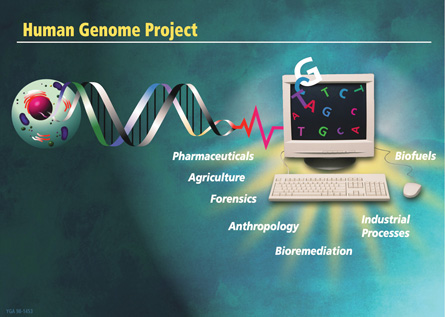Module 7
1. Module 7
1.22. Page 2
Module 7—Molecular Genetics: DNA, RNA, and Protein Synthesis
 Explore
Explore
 Read
Read
Scientists from around the world have worked together on the Human Genome Project. This was a true scientific collaboration involving contributions from Canada, the US, the UK, Japan, France, Germany, China, and other countries.
The goal of the project was to identify the three billion nucleotide base pairs that make up the human genome. The project took 13 years (less then the estimated 15 years due to technology advances) and ended in 2003. The result became a “sourcebook” for medical science that helps researchers understand and treat over 4000 genetic diseases. Note the image provided of human chromosome #1 and the genes coded for by 246 million base pairs. And this is just one chromosome! How could this knowledge be useful? Some of the potential and current beneficial applications of this project include:
- molecular medicine
- energy sources and environmental applications
- risk assessment
- bioarchaeology, anthropology, evolution, and human migration
- DNA forensics (identification)
- agriculture, livestock breeding, and bioprocessing
In this lesson you will be concentrating on the evolutionary and DNA forensics applications of the findings of the Human Genome Project. If you would like further information on the other beneficial applications mentioned above, do a search on the Internet using terms “Human Genome Project” or “genomics + energy +gov + genome project + US Department of Energy.”
For more information about human genomes, click on “base pairs1.”
1 Image courtesy of the U.S. Department of Energy Genome Programs (http://genomics.energy.gov)
 Watch and Listen
Watch and Listen
DNA fingerprint: the pattern of bands into which DNA fragments sort during gel electrophoresis; this pattern is unique for every individual except twins and other multiple-birth people
Watch the video “The Human Genome Project: Identity of the Future,” which explains the project’s goals, benefits, issues, and concerns. The video also introduces DNA fingerprinting, which will be discussed in the next Read section. As you watch, create a list of all of the benefits and drawbacks and/or concerns associated with the Human Genome Project. Place this list in your course folder for future reference. Contact your teacher to obtain a username and password required to access the video.
 Discuss
Discuss

Image courtesy of the U.S. Department of Energy Genome Programs (http://genomics.energy.gov)
This image is one of the many posters used to promote the Human Genome Project. The poster describes the areas or fields that will be impacted by the knowledge gained from the Human Genome Project. Choose another of these fields, other than forensics and evolution, to research. Do an Internet search for “Human Genome Project Information.”
Find out how the Human Genome Project (HGP) will, or has, impacted the field of study you have chosen. Create a one-paragraph discussion posting to share with students in your class. Discuss benefits and any disadvantages associated with the use of the HGP information.
 Read
Read
gel electrophoresis: tool used to separate molecules according to their mass and charge; can be used to separate fragments of DNA
The video the “Human Genome Project: Identity of the Future” described the process and uses of DNA fingerprinting. Review the tool of DNA fingerprinting, gel electrophoresis, by reading “Sorting and Analyzing DNA” from pages 649 to 651 of your textbook. Using a diagram, flow chart, or point form, outline the steps in the gel electrophoresis procedure for your course folder.
 Self-Check
Self-Check
Through the video and reading above you should now know that DNA fingerprinting has many uses. The most well-known use is the identification of criminals in forensics labs. Lesser-known uses for DNA fingerprinting are the identification of harmful strains of bacteria, the diagnosis of inherited disorders, management of wildlife genetic variation, and even the identification of the exact grapes used in a wine. The uses for this technology are endless. This technology is also used to identify relationships between human beings. Given that half of the nuclear DNA of a child originates from the mother and the other half is from the father, this information and DNA fingerprinting technology can be used to identify biological parents.
SC 1. Read “Thought Lab 18.5: Reading a DNA Fingerprint" on page 651. Answer the “Analysis” questions to test your knowledge of DNA fingerprinting. Check your answers.
 Self-Check Answers
Self-Check Answers
SC 1.
- The parents of the child are Parents B. They are the only parents that have all of the same DNA segments as the child.
- Five of the child’s DNA segments (50 percent) match the mother and the other five (50 percent) match the father.
- Other situations in which DNA fingerprinting may be useful are in paternity cases, in identifying the remains of murder or accident victims, in tracing the movement of wildlife, or in plant and animal breeding programs.
 Try This
Try This
Real-World Applications
TR 1. Research some real examples of DNA fingerprint analysis being used to solve crimes or identify people.